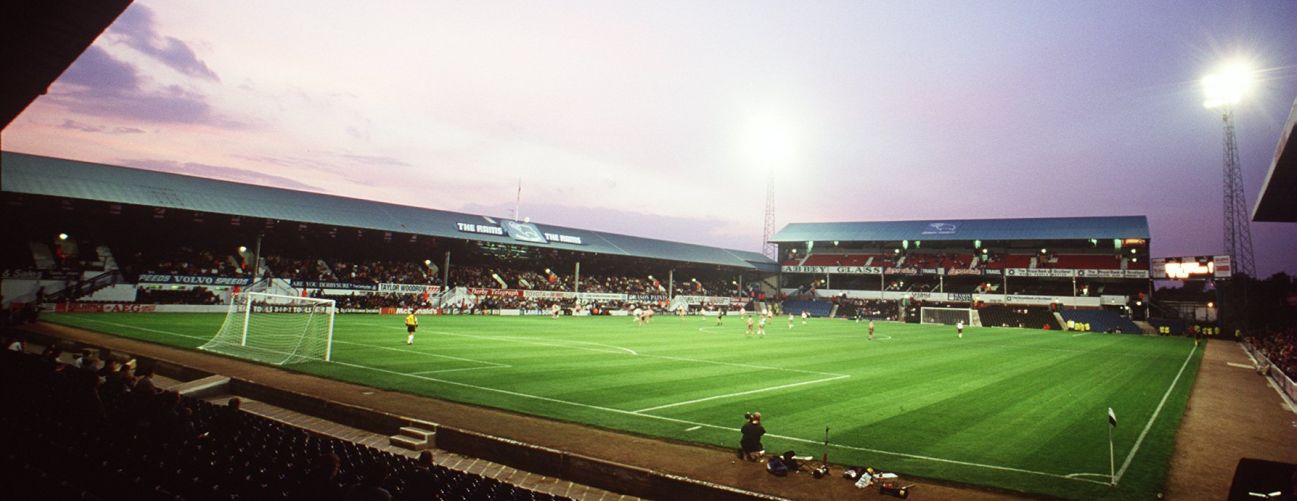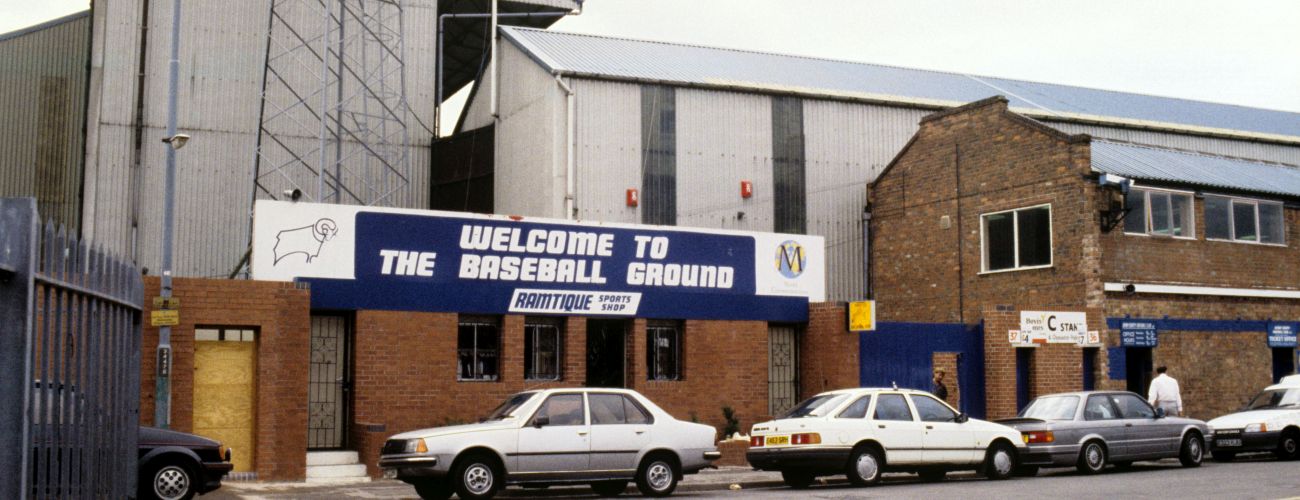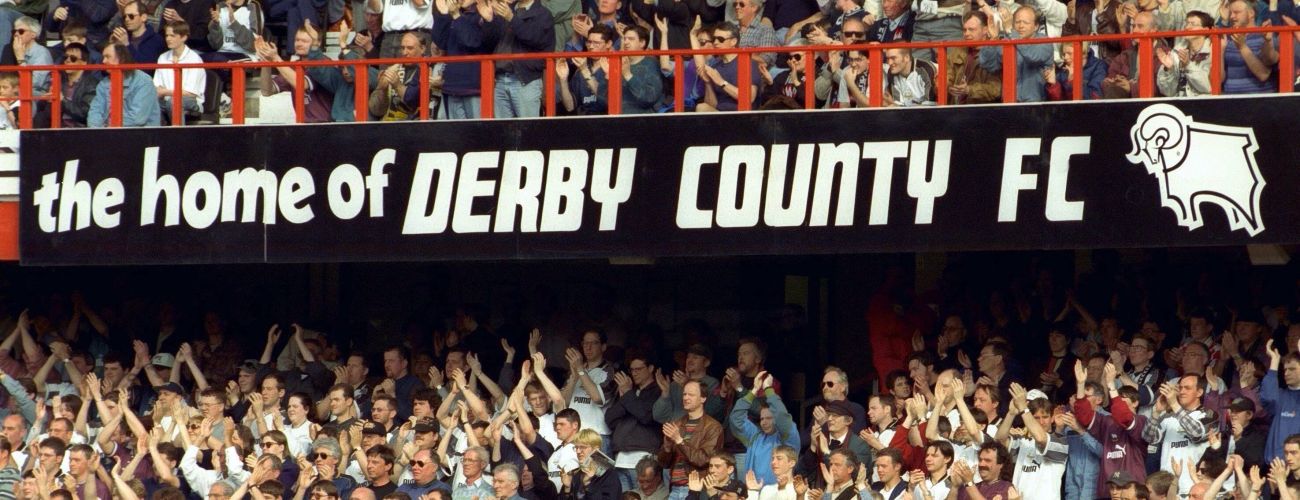The Baseball Ground, 1895 to 1997
As they were formed as an offshoot of Derbyshire County Cricket Club, it was natural for Derby County to set out at the County Ground on Nottingham Road, where they stayed until 1895 when they moved to the Baseball Ground, which would be their home for 102 years before moving to Pride Park Stadium in 1997.
Francis Ley laid out a sports ground in the 1880s in order that employees at his Vulcan Works foundry should have recreational facilities. After a visit to the United States in 1889, Ley introduced baseball to the area, hence the name of the ground, but like other imported sports, it struggled to gain a firm footing. Derby County won the English Cup at baseball in 1897, with Steve Bloomer at second base. Ley, later Sir Francis, had already spent £7,000 to improve the Baseball Ground and added another £500 to extend the football pitch and transfer stands from the County Ground, Derby County's former home. There were fears that the attendances would suffer but there was almost a captive audience with so many from the foundry and the railway works living on the doorstep. The first home match as full tenants, on 14 September 1895, brought a 2-0 victory over Sunderland, both goals scored by Bloomer, and an attendance estimated at 10,000. The Rams were on the way to their best finish so far, runners-up in Division One.
The Football Association recognized Derby's standing in the game, although they were then in Division Two, with an international against Ireland in February 1911. There were no Derby players involved but Rams followers had the chance to see one of their former favourites, Ben Warren of Chelsea, as England won 2-1. Soon after moving, Derby expressed an ambition to buy the Baseball Ground but had an opportunity to move again in 1923. It was a new conception, a stadium funded by the Corporation in return for an annual rent of £500. The site was the Municipal Sports Ground on Osmanton Park Road, described at the time as being in the wilds of Allenton. Housing developments soon made it distinctly urban. The club broke off the talks and, in July 1924, bought the freehold of the Baseball Ground from Sir Francis Ley for £10,000. When they were promoted under George Jobey in 1925/26, an ambitious development plan was set in motion and Derby engaged the services of Achibald Leitch, the foremost designer of football grounds.

Work began immediately on a new main stand, known as B Pavilion, with a frontage on Shaftesbury Crescent. The dressing rooms and offices were moved under it so that, for the first time at the Baseball Ground, players emerged from the side rather than an end.
The Popular side came next. The terracing was deepened towards the front, with gangways going across, and a roof was built later, with a higher step in the centre. The roof offered advertising space, for many years proclaiming the virtues of Offiler's Ales. When that brewery closed, there was a message asserting, to general disbelief, that the Bus Station café offered 'the best feed in town'. With Jobey as manager, Derby were an attractive side, even if major prizes continued to elude them. The demand for increased accommodation was answered in 1933 by the construction of the double-decker stand at the Osmaston End, although it did not fill the entire width. The north-eastern section, known as Catcher's Corner, from the baseball days, remained uncovered. There was a small hut and a platform, in front of which half-time scores were displayed. The Normanton End stand, similar in design, opened in 1935 so, in less than a decade, the capacity increased from around 20,000 to 38,000. The Osmaston End was damaged in January 1941, during a German air-raid, and remained out of commission as the Rams made their way towards the 1946 FA Cup final, although not entirely unoccupied as supporters were prepared to take risks.

Once that was repaired, the Baseball Ground had the look familiar to post-war generations but there was another chance for the Rams to have a new home. Maxwell Ayrton, who had been involved in the construction of Wembley Stadium, submitted an attractive design for the Municipal Sports Ground site, but the directors again elected to stay where they were. Apart from the installation of floodlights, set low on the corners of the end stands in 1953, nothing changed significantly at the Baseball Ground until 1969. As in 1926, Derby took advantage of promotion, this time under Brian Clough and Peter Taylor, to increase capacity. A fourth stand was squeezed in above the Pop side, backing against Ley's Malleable Castings. Derby obtained enough land from their neighbours to make the construction feasible, naming it the Ley Stand in recognition, but so cramped was the site that access to the seats was possible only with walkways above the terracing. Priority was given to supporters prepared to buy seats for two years, and such was the enthusiasm generated by the Clough era that there was no problem in finding buyers. For the first time, Derby could cope with 40,000 crowds and, for a time, had one of the few grounds with seating and standing accommodation on all four sides. Entry into the European Cup in 1972 compelled the installation of new floodlights to match UEFA specifications. This development was a considerable relief to Press photographers, who had struggled through the gloom of outmoded lights for years.

The 1970s were the best days of the Baseball Ground. After Derby County's second League title, in 1974/75, the team and the club's finances deteriorated. So did their home. In a period of crowd trouble throughout the game, fences around the pitch came and, after the Hillsborough disaster, went. The Taylor Report pushed clubs towards seating throughout but the confines of the Baseball Ground made conversion difficult. Seats bolted on terracing are not the same as areas designed for seating and there were misjudgments, such as sitting a family area at the Osmaston End directly below visiting supporters. For local residents, Derby's home matches became a regular ordeal because crowd violence was in fashion. By the time Derby left in 1997, capacity was under 18,000. Land was available for a new stadium when the City of Derby earned £37.5 Million from the City Challenge Awards, a scheme for regenerating urban areas. Derby was a candidate to stage the Millennium celebrations, although clearly outsiders despite excellent road, rail and air communications. That prize was destined for London. Pride Park was based on the former Chaddesden Sidings and a gas plant. The soil had to be decontaminated and in August 1993 the Derby board voted to move. A wildly optimistic scheme by a company called Stadivarios failed to advance the project, so the plans were scraped in January 1995 in favour of staying at the Baseball Ground. Designs were conceived for a massive redevelopment that would have left on the Ley Stand, its name now changed for sponsorship purposes, in use. For all that many hearts cherished the Baseball Ground; it would have been a completely different arena, while retaining the difficulties access for a car-based support. Pride Park needed a central attraction and Peter Gadsby, a property developer who was then the club's vice-chairman, was restless about the decision, finally seeing the chance to acquire land on favourable terms. The announcement was made at the Baseball Ground on 21 February 1996, just before the Derby County and Luton Town teams emerged. At the third time of asking, Derby were to move and caught the tide with a successful team, heading for promotion under Jim Smith. The first Premiership season was at the Baseball Ground while the new stadium took shape, Arsenal the final opponents on 11 May 1997.
Even then, the Baseball Ground was not finished, as reserve matches continued there. The site was not cleared until 2004 and, when the stands went, the overriding impression was the smallness of the area. Did Juventus and Real Madrid really play European Cup matches in that tiny space?!

The Baseball Ground was renowned for its atmosphere, best savoured for a night match when the sparks flew at the foundry and the fumes gave a special tang. It was also famous for an awful pitch, in part a consequence of the playing area being below street level and creating drainage problems. After the second Championship, the pitch was dug up, with earth from the centre circle sold in plastic bubbles attached to a commemorative card, but the surface was never ideal. The Baseball Ground was home to generations of Derby supporters, a typical product of football's development in the Victorian age. Derby County, like many other clubs, realised it was time to move on.
The Baseball Ground will, forever, hold a special place in the history of Derby County.


 3/1 To Win
3/1 To Win

















